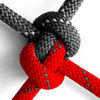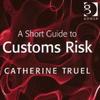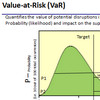There are a surprisingly large number of applications of air photos in emergency management. These range, among others, from pre-disaster mitigation planning through damage surveys to evacuation studies. Air photos can capture a lot more information than field surveys can, and can assist in a number of situations. Air photos are a tool which should not be left out in any form of emergency management.
Introduction
For most of our history we humans have had a limited view of the world around us, based on what we could see in our immediate neighborhood. In order to gain an over-view literally speaking, we had to climb trees, mountains or high structures. It was only after the advent of the hot air balloon and later the airplane that a full overview of the ground became possible. Since then, aerial photography has played an important role in providing valuable information, foremost for the construction of maps and for military surveillance.
With the ever-increasing resolution of satellite imagery, aerial photography seems to be facing its demise. However, aerial photography is not dead yet. One application, that is often overlooked, and not commonly mentioned in current literature, is the use of aerial photography in emergency management. The reason may be that emergency management is a vast field itself, where aerial photography is only one of many components. This paper will attempt to address different applications related to emergency management and will attempt to highlight its advantages, as well as limitations.
Most of the applications presented here have arisen from the authors personal knowledge of the field of emergency management, as planning consultant to a number of local municipalities in his home country, Norway.
Aerial Photography
The term aerial photograph, or simply air photo, describes a photograph taken from above the earths surface, as opposed to ground photographs, where the photographer is operating on the earth’s surface. Aerial photography denotes the process of taking photographs from above the earth’s surface. Usually this is done from aircrafts, meaning airplanes, but other means can also be used, such as helicopters, airships or remotely controlled airships, often called blimps. Even pictures taken from a high structure, such as a television tower, can bear the term air photo. Depending on the orientation of the camera’s optical axis with respect to the earth’s surface, air photos are classified as vertical or oblique.
Vertical aerial photographs
Vertical air photos are those taken with the camera’s optical axis in a vertical or near-vertical angle to the ground surface. Vertical air photos present relatively undistorted overhead views of the landscape and are essential for accurate mapping and photo interpretation. It can be assumed that the vertical air photo represents a true record of angles between ground objects, but horizontal measurements are dependent on the variation of the ground surface and flight altitude. In addition, overlapping vertical air photos can be viewed stereoscopically to produce three-dimensional views of the landscape, thus allowing height measurements.
Oblique aerial photographs
Oblique air photos are air photos taken with the camera intentionally tilted away form the vertical by an angular amount that exceeds 20º. Oblique photos that show the horizon are often called high-oblique, whereas oblique photos that do not show the horizon are called low-oblique.
Digital Orthophoto Quad (DOQ)
Digital Orthophoto Quads. DOQs are air photos in digital format, which have been rectified to generate an orthophoto that is a spatially accurate image with planimetric features represented in their true geographic positions. In other words, an aerial photo that is as accurate as a map.
The standard digital orthophoto produced by the U.S. Geological Survey (USGS) is a black-and-white or color-infrared digital image map. Each DOQ covers 3.75-minutes of longitude and 3.75-minutes of latitude. It is referenced to the North American Datum of 1983 and is cast upon the Universal Transverse Mercator projection. Each pixel represents 1 square meter on the ground. Every DOQ has between 50 and 300 meters of overedge image beyond the primary and secondary quadrangle corner ticks. This overedge facilitates tonal matching and mosaicking of adjacent images. (AGRC, 2001)
High and low altitude photos
The ability to discern detailed ground features decreases with increasing flight altitude. Air photos for mapping purposes, e.g. creating 1:24,000 USGS 7.5′ quads usually have a scale of 1:20,000 -1:30,000.This is too coarse for a detailed damage survey or evacuation planning, but it gives an excellent situation overview, since a 1:25,000 9×9 inch photo covers approximately 14 square kilometers. Oblique photos are in general low-altitude and not only provide ground details but also perspective, something that is missing in vertical air photos. Even stereoscopic viewing of vertical air photos does not generate perspective to the same extent that oblique photos do.
Emergency management
Emergency management personnel often rely on geographic information, and especially aerial photographs, for purposes of site analysis and operations support. During and after natural and man-made disasters, the requirements for rapid accessing of geographic data are particularly acute. Typically, access time needs to be on the order of minutes to hours and engineered for a range of skill levels and computing resources. Aerial photography is a valuable data source to address these needs because aerial photography is of broad utility, intuitive to use and cost effective to acquire.
Disaster documentation and future planning
One major application of any photographic record is documenting what actually happened; firstly, to serve as a historic record, and secondly to serve as training material for future events. Taking air photos during a disaster will not only preserve the scene of an emergency, it will provide information on the damage extent, and foretell what to expect the next time a disaster strikes. This can help locate vulnerable structures, sites that need to be preserved better or areas that should have an emergency evacuation plan ready. It is indeed a very common procedure for police and other involved emergency agencies to engage in reconnaissance flights, viewing an emergency site from the air and taking photos.
To take the case of a flash flood as an example, documenting the disaster area extent will provide valuable information that might indicate zones where buildings should be restricted and where resurrection of damaged buildings should not be allowed because of the danger of future events.
Ground control and guidance for emergency response teams
Emergency response teams rely on their personal geographic knowledge and the information given by the dispatcher in finding the site of an emergency. The dispatcher relies on the location given by the caller and even if the address is given correctly, the emergency response crew may not know exactly what is the shortest or fastest way to the scene, particularly in rural or residential areas.
In rural areas, the crew may take wrong turn and become completely lost in relation to the incident. Residential areas are full of one-way streets and cul-de-sacs. Especially if the road is blocked by debris, for instance after a tornado, finding a way through to the scene can be time-consuming.
The use of a route-finding application within a GIS (Geographic Information System), giving a map and clear directions is a valuable tool. However, a map does not tell you what is on the ground and if the accident scene is in the backcountry, even a GIS will most likely fail. Here, aerial photograph can be used as a backdrop in a GIS, instead of a map. This will easily identify ground features that can aid crews in finding their way. One example of such photos is the so-called DOQs, which can be directly imported into a GIS.
Oblique air photos may actually provide a better tool than flat DOQs, since they provide perspective and often also color, which makes recognizing ground features easier than from a black and white vertical air photo.
Evacuation Planning
Air photos are excellent tools for evacuation planning. If recent enough, they will give a almost true picture of what is on the ground, residential or non residential, single houses or apartment blocks, which streets that lead in or out of subdivisions and thus potential bottlenecks.
Air photos will also help identify potentially hazardous sites, factories, nuclear power plants etc. and their surroundings, and aid in determining evacuation zones and best routes.
In the event of a major flood, air photos will identify areas that are under water and isolated isles not flooded that need to be acted on quickly. Even though a high-resolution DEM (Digital Elevation Model) can assist in forecasting the extent of a flood, water will often not behave in practice as we assume in theory. Levees may break at unexpected points and flooding areas presumed to be safe and streams will find their path according to even minute differences in elevation, differences a DEM will not be able pick up fully. Spots like these can be seen on air photos and help direct resources to where they are needed most.
Landslide investigation
Landslides are usually recognizable in aerial photographs by their characteristic shapes and internal features created by slope failure. Air photos not only document actually occurring landslides, but will also indicate landslide-susceptible terrain, bringing us back to the previous section on future mitigation planning.
Hazardous spill detection
An accidental discharge of toxic fluid into a lake or a stream is usually highly visible on air photos because of differences in coloration. Air photos can document the extent and flow direction, indicate potential dangers zones and direct response teams to the source of the spill. Such discharges are often not visible form the ground when they occur and may often be accidentally detected by an aircraft flying over.
More relevant is the use of air photos in the case of oil spills, since they often involve longer lasting clean-up operations, and may extend over a large area. Air photos will document affected areas, how the oil film moves on the water surface and thus direct the appropriate response measures.
Post-disaster damage survey
Air photos, combined with photo interpretation, is an established method of gathering and analyzing data, following large natural or man-made disasters that result in physical damage. This method enables several types of damage survey to be made quickly. For example, initial estimates of damage to property and facilities for a disaster that stretches over a large area can be made more quickly than by field observation on the ground. (Avery, 1992)
Following a disaster, especially in remote areas, or in developing countries, high flying aircraft can take photos of areas, where little is known about the damage extent, because of little or no means of modern telecommunications.
Disaster recovery planning
This is a direct follow up of the previous section. Once the damage extent and type of damage has been determined, the needed recovery clean-up can be directed as necessary. Air photos can help tell where resources should be used first, and what kind of resources. If there is a lot of structural damage, heavy machinery may be required. If there is a downfall of trees, you would need crews with motor saws and axes. If transmission lines are damaged, you need electrical teams and so forth.
Conclusion
There are a surprisingly large number of applications of air photos in emergency management. This essay does not intend to be exhaustive, so many more applications and examples could certainly have been mentioned. All in all, it has only presented a brief cross-section of the uses of air photos in emergency management.
Based on the above, it is difficult to tell whether vertical or oblique photos are best suited. Bearing in mind the rapid response that is often required in conjunction with emergencies, oblique photos taken from helicopters or small, low-flying airplanes seem to be the best solution. Nevertheless, in the case of the slowly developing disaster, like a flood along the Mississippi River, high altitude vertical photos appear to have their definite place. In any case, the tool used must fit the task in question.
Air photos can provide emergency managers with considerable more information for decision support than field surveys can, and they certainly allow for an oversight evaluation of any emergency situation. In conclusion, air photos are a valuable tool, that should not be left out in any form of emergency management.
References
Philipson, W.R. (ed.) (1997) Manual of Photographic Interpretation. American Society for Photogrammetry and Remote Sensing.
Avery, T. and Berlin, G. (1985) Interpretation of Aerial Photographs. Fourth Edition.
Lee, C.M. (2001) Aerial Photo Interpretation. Lecture notes from 5100/6100, Spring 2001
AGRC (2001) Uses for Digital Orthophotos. A description of the USGS DOQs, taken form the AGRC website.
Reference
Husdal, J (2001). The use of air photos in emergency management. Unpublished coursework. University of Utah, USA.
Related
- husdal.com: Issues in risk visualization












